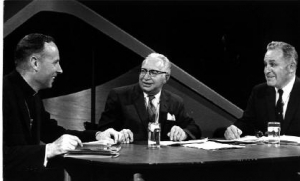In March of 1942 most of the United States was focused on the second World War in less than 30 years. As bombs flew over Europe, less obvious bombs flew over America. These bombs were not in the form of artillery, but in the equally explosive form of anti-semitism and general Jewish prejudice.  The belief that Jews were inferior to whites because of racial identity had begun to take hold since the 1920’s. It was in this social environment that a Jewish temple in the Pacific Northwest called Temple de Hirsch was welcoming the entrance of their brand new Rabbi, Raphael Levine. It became Levine’s mission to counter such prejudicial thoughts. His mission began with sermons to his congregation aimed at preventing the further spread of ideas that would signify Jews as a race. Instead, he continued he wrote a book focusing on Judaism as a religion and attempted to cement the idea in American culture by creating unity between Jewish and Christian faiths. He would create unity through his creation of the avant garde television program “Challenge” in 1960 as a response to the nomination of John F. Kennedy for president. The show brought together three different traditions in a unique way.
The belief that Jews were inferior to whites because of racial identity had begun to take hold since the 1920’s. It was in this social environment that a Jewish temple in the Pacific Northwest called Temple de Hirsch was welcoming the entrance of their brand new Rabbi, Raphael Levine. It became Levine’s mission to counter such prejudicial thoughts. His mission began with sermons to his congregation aimed at preventing the further spread of ideas that would signify Jews as a race. Instead, he continued he wrote a book focusing on Judaism as a religion and attempted to cement the idea in American culture by creating unity between Jewish and Christian faiths. He would create unity through his creation of the avant garde television program “Challenge” in 1960 as a response to the nomination of John F. Kennedy for president. The show brought together three different traditions in a unique way.
Why use religion? The answer has all to do with the social context of the time. The Cold War was just beginning to heat up at the beginning of his unification efforts of the two faiths. It was a war against the Godless Communists. So, in a way, having  a God was a very important piece of being American. By emphasizing religion, specifically a religion that seemed very close to the dominant Protestant religion, Jews became more American.
a God was a very important piece of being American. By emphasizing religion, specifically a religion that seemed very close to the dominant Protestant religion, Jews became more American.
Levine wanted the Jews to be considered truly American because it furthered his goal of removing anti-semitism and prejudice. America had not yet granted equal rights to minority groups such as African Americans, so there was not the same value in diversity that there is today. Thus, removing the “non-American” attributes of Judaism would be beneficial for Jews seeking to be thought of equally.
The special collections library at the University of Washington offers a wealth of resources speaking to these very issues. In these collections are sermons and letters that discuss and address how Levine handles these difficult topics. By analyzing them thoroughly, patterns consistently emerge with Levine’s themes of Jewish religious identity, Levine fighting antisemitism, and American acculturation.
In order to give context social and historical background for this site, we will look at various secondary sources such as the Temple de Hirsch website, for its description of Levine, a Jewish History textbook, for the description of social context, and an interview of Father Tracey on the life of Rabbi Levine, for personal character description. For more information on the sources check the Sources page.